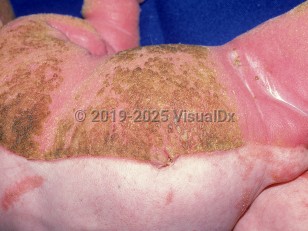CHILD syndrome
Alerts and Notices
Important News & Links
Synopsis

Congenital hemidysplasia with ichthyosiform erythroderma and limb defects (CHILD) syndrome is a rare, X-linked dominant disorder caused by loss of function mutations in the NSDHL gene, which encodes NAD(P)H sterol dehydrogenase-like protein. These mutations result in disruptions of the distal cholesterol biosynthetic pathway with accumulation of toxic metabolic intermediates. The syndrome typically presents in female infants at birth or within the first few months of life. A male infant presumed to have postzygotic mutations has been reported. The hallmark of this condition is the presence of strikingly unilateral ichthyosiform plaques with a sharp midline demarcation in association with ipsilateral defects of other organ systems. These can include the musculoskeletal, cardiovascular, pulmonary, renal, genitourinary, endocrine, and central nervous systems.
Codes
ICD10CM:
Q87.89 – Other specified congenital malformation syndromes, not elsewhere classified
SNOMEDCT:
17608003 – Child syndrome
Q87.89 – Other specified congenital malformation syndromes, not elsewhere classified
SNOMEDCT:
17608003 – Child syndrome
Look For
Subscription Required
Diagnostic Pearls
Subscription Required
Differential Diagnosis & Pitfalls

To perform a comparison, select diagnoses from the classic differential
Subscription Required
Best Tests
Subscription Required
Management Pearls
Subscription Required
Therapy
Subscription Required
References
Subscription Required
Last Reviewed:05/25/2020
Last Updated:01/12/2022
Last Updated:01/12/2022
CHILD syndrome

